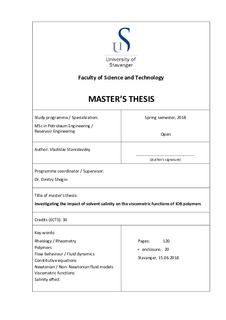| dc.description.abstract | One of the promising methods of enhanced oil recovery (EOR) is injection of polymers dissolved in low salinity water. This leads to a dramatic increase in the sweep efficiency due to increased apparent viscosity. It is well known that locally charged EOR polymers interact with salt ions in the solvent, which leads to a drop in the apparent viscosity i.e. the polymer solutions lose their desired property. The main focus of this work is to study the effect of salinity by a numerical analysis of rheological measurements conducted for several EOR polymers typically used in oil recovery operations. In particular, an important research question resolved in this thesis is how the functional form of the dependency of non-Newtonian viscosity on the local shear rate is changed with salt concentration in different brine solutions.
Taking into consideration that polymer solutions are non-Newtonian fluids and do not obey the laws of classical fluid dynamics, in order to describe the behaviour of these fluids in complex flows (like those in porous media), advanced fluid models need to be used. In this thesis the best possible prediction of the non-Newtonian viscosities of the considered polymeric solutions were suggested by testing several differential tensor non-Newtonian fluid models. The major non-Newtonian fluid models, that were juxtaposed with the data obtained throughout the experimental work, were FENE-P dumbbell model, Linear and Exponential Phan-Thien-Tanner models.
However, at the present time, salinity is not accounted for in these models. Thus, the major focus of the thesis is to give a hint on what kind of behaviour must be predicted by the future non-Newtonian fluid models that should take into account relation of the scalar parameters in the models and salinity of the solvents, as well as considering polymer concentration in the solutions and polymer molecular weight. | nb_NO |
